Strategic Planning and Competitive Analysis: Amazon and Google Cases
VerifiedAdded on 2022/10/10
|19
|4068
|300
Report
AI Summary
This report provides a comprehensive analysis of the strategic management practices of Amazon and Google, based on provided case studies. The report begins by examining Amazon's acquisition of Whole Foods, critiquing its mission statement, assessing the impact of the macroeconomic environment, and analyzing the company's competitive strategies, particularly cost leadership. It explores the rationale behind the acquisition, identifying the risks associated with entering the grocery market. The report then shifts to Google, analyzing its competitive strategies, the factors influencing the launch of Tez, and the challenges faced in the mobile payment market. It delves into Google's international strategies, specifically in the context of Tez's launch in India, and discusses the replication of success in growing economies. The report follows a structured approach, addressing specific questions related to each case, defining key terms, providing supporting evidence, and adhering to the requirements of a formal report, including introduction, conclusion, and references.
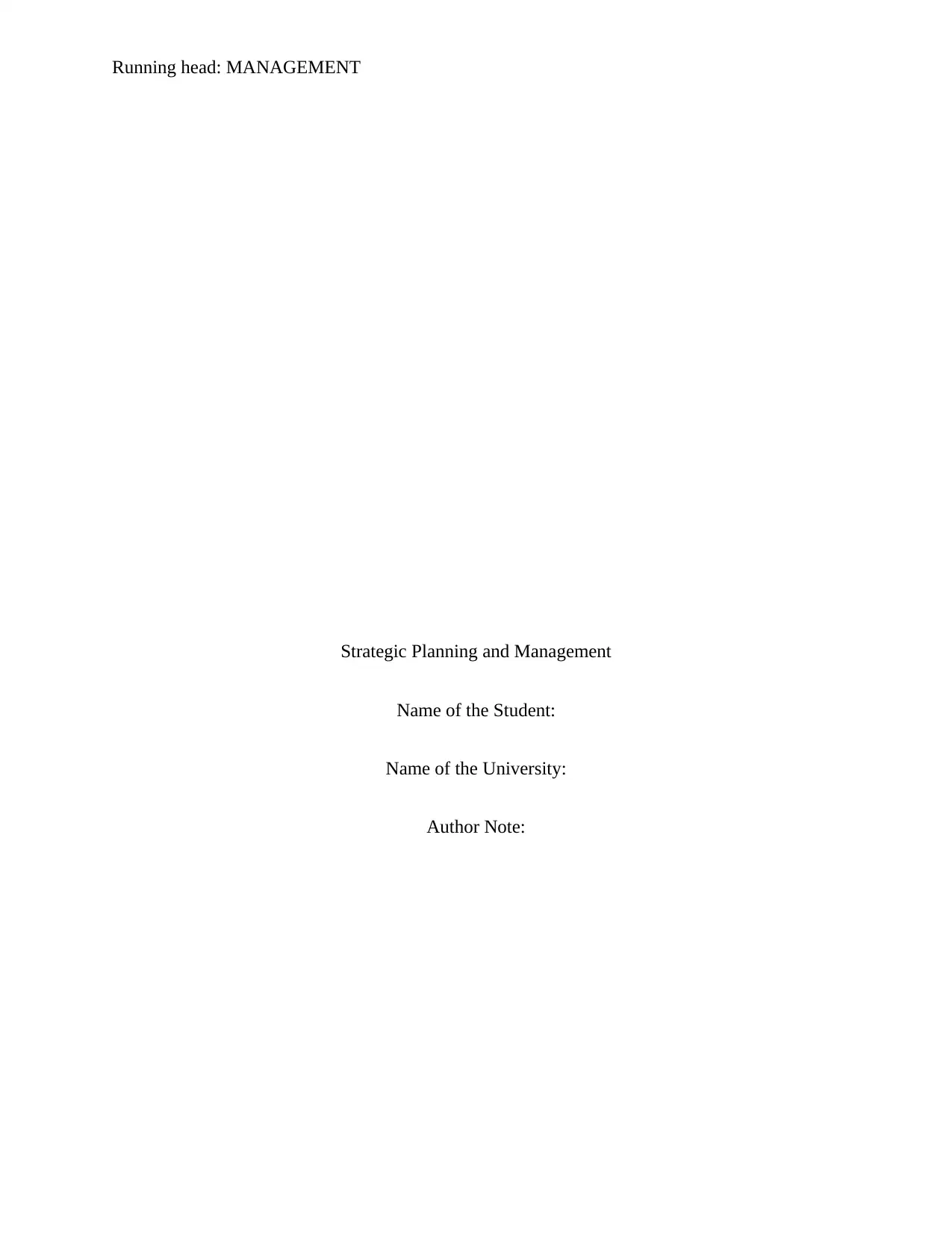
Running head: MANAGEMENT
Strategic Planning and Management
Name of the Student:
Name of the University:
Author Note:
Strategic Planning and Management
Name of the Student:
Name of the University:
Author Note:
Paraphrase This Document
Need a fresh take? Get an instant paraphrase of this document with our AI Paraphraser
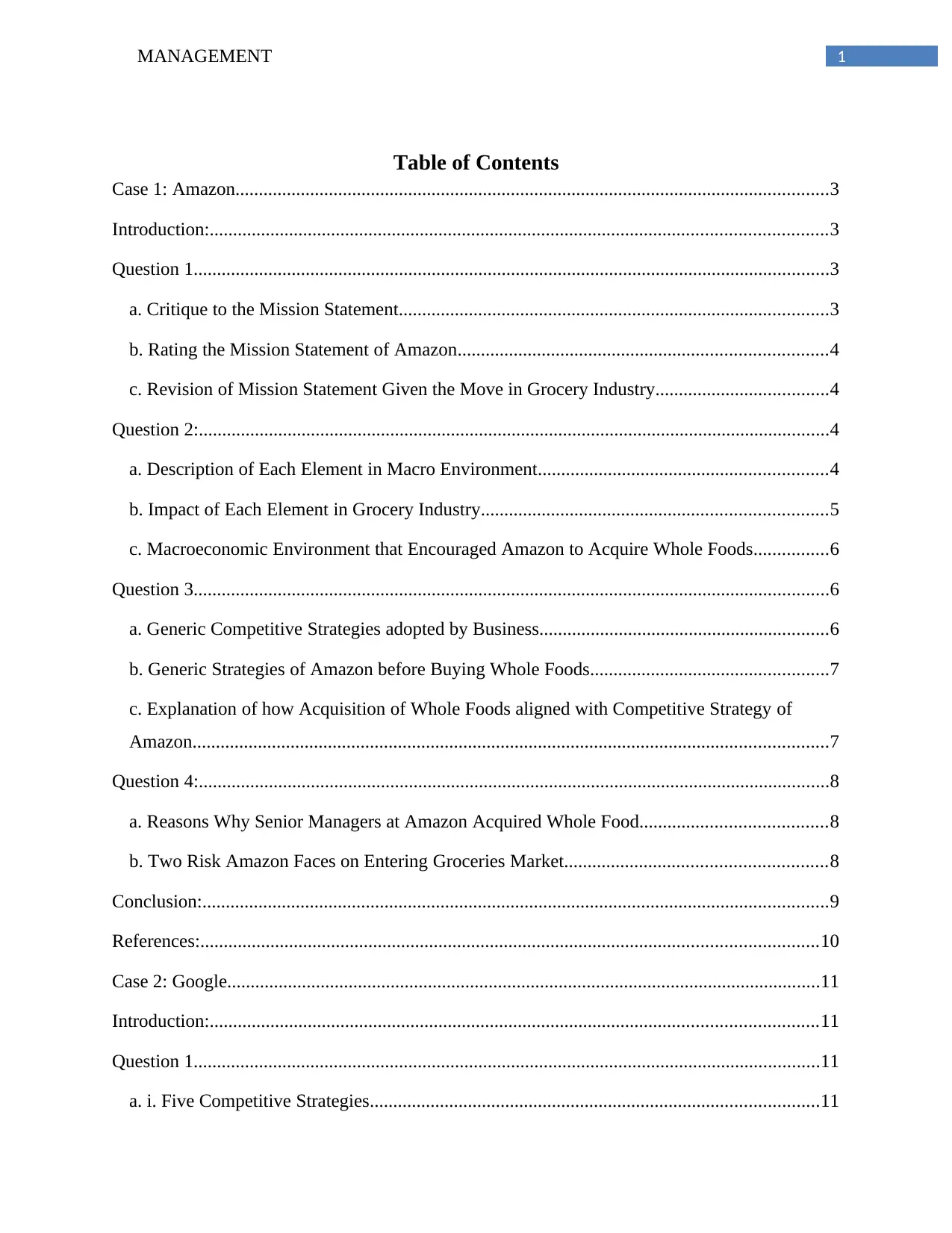
1MANAGEMENT
Table of Contents
Case 1: Amazon...............................................................................................................................3
Introduction:....................................................................................................................................3
Question 1........................................................................................................................................3
a. Critique to the Mission Statement............................................................................................3
b. Rating the Mission Statement of Amazon...............................................................................4
c. Revision of Mission Statement Given the Move in Grocery Industry.....................................4
Question 2:.......................................................................................................................................4
a. Description of Each Element in Macro Environment..............................................................4
b. Impact of Each Element in Grocery Industry..........................................................................5
c. Macroeconomic Environment that Encouraged Amazon to Acquire Whole Foods................6
Question 3........................................................................................................................................6
a. Generic Competitive Strategies adopted by Business..............................................................6
b. Generic Strategies of Amazon before Buying Whole Foods...................................................7
c. Explanation of how Acquisition of Whole Foods aligned with Competitive Strategy of
Amazon........................................................................................................................................7
Question 4:.......................................................................................................................................8
a. Reasons Why Senior Managers at Amazon Acquired Whole Food........................................8
b. Two Risk Amazon Faces on Entering Groceries Market........................................................8
Conclusion:......................................................................................................................................9
References:....................................................................................................................................10
Case 2: Google...............................................................................................................................11
Introduction:..................................................................................................................................11
Question 1......................................................................................................................................11
a. i. Five Competitive Strategies................................................................................................11
Table of Contents
Case 1: Amazon...............................................................................................................................3
Introduction:....................................................................................................................................3
Question 1........................................................................................................................................3
a. Critique to the Mission Statement............................................................................................3
b. Rating the Mission Statement of Amazon...............................................................................4
c. Revision of Mission Statement Given the Move in Grocery Industry.....................................4
Question 2:.......................................................................................................................................4
a. Description of Each Element in Macro Environment..............................................................4
b. Impact of Each Element in Grocery Industry..........................................................................5
c. Macroeconomic Environment that Encouraged Amazon to Acquire Whole Foods................6
Question 3........................................................................................................................................6
a. Generic Competitive Strategies adopted by Business..............................................................6
b. Generic Strategies of Amazon before Buying Whole Foods...................................................7
c. Explanation of how Acquisition of Whole Foods aligned with Competitive Strategy of
Amazon........................................................................................................................................7
Question 4:.......................................................................................................................................8
a. Reasons Why Senior Managers at Amazon Acquired Whole Food........................................8
b. Two Risk Amazon Faces on Entering Groceries Market........................................................8
Conclusion:......................................................................................................................................9
References:....................................................................................................................................10
Case 2: Google...............................................................................................................................11
Introduction:..................................................................................................................................11
Question 1......................................................................................................................................11
a. i. Five Competitive Strategies................................................................................................11
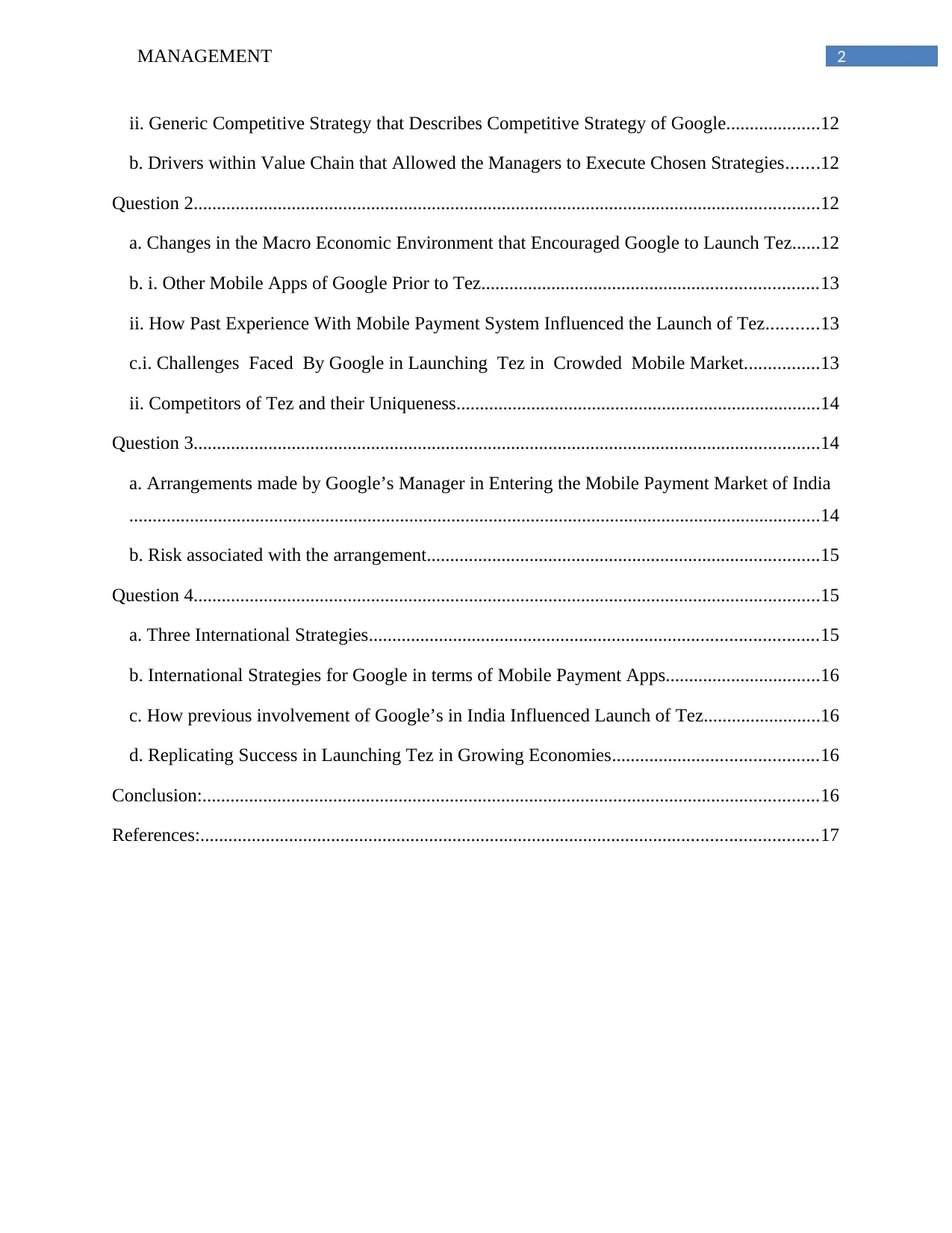
2MANAGEMENT
ii. Generic Competitive Strategy that Describes Competitive Strategy of Google....................12
b. Drivers within Value Chain that Allowed the Managers to Execute Chosen Strategies.......12
Question 2......................................................................................................................................12
a. Changes in the Macro Economic Environment that Encouraged Google to Launch Tez......12
b. i. Other Mobile Apps of Google Prior to Tez........................................................................13
ii. How Past Experience With Mobile Payment System Influenced the Launch of Tez...........13
c.i. Challenges Faced By Google in Launching Tez in Crowded Mobile Market................13
ii. Competitors of Tez and their Uniqueness..............................................................................14
Question 3......................................................................................................................................14
a. Arrangements made by Google’s Manager in Entering the Mobile Payment Market of India
....................................................................................................................................................14
b. Risk associated with the arrangement....................................................................................15
Question 4......................................................................................................................................15
a. Three International Strategies................................................................................................15
b. International Strategies for Google in terms of Mobile Payment Apps.................................16
c. How previous involvement of Google’s in India Influenced Launch of Tez.........................16
d. Replicating Success in Launching Tez in Growing Economies............................................16
Conclusion:....................................................................................................................................16
References:....................................................................................................................................17
ii. Generic Competitive Strategy that Describes Competitive Strategy of Google....................12
b. Drivers within Value Chain that Allowed the Managers to Execute Chosen Strategies.......12
Question 2......................................................................................................................................12
a. Changes in the Macro Economic Environment that Encouraged Google to Launch Tez......12
b. i. Other Mobile Apps of Google Prior to Tez........................................................................13
ii. How Past Experience With Mobile Payment System Influenced the Launch of Tez...........13
c.i. Challenges Faced By Google in Launching Tez in Crowded Mobile Market................13
ii. Competitors of Tez and their Uniqueness..............................................................................14
Question 3......................................................................................................................................14
a. Arrangements made by Google’s Manager in Entering the Mobile Payment Market of India
....................................................................................................................................................14
b. Risk associated with the arrangement....................................................................................15
Question 4......................................................................................................................................15
a. Three International Strategies................................................................................................15
b. International Strategies for Google in terms of Mobile Payment Apps.................................16
c. How previous involvement of Google’s in India Influenced Launch of Tez.........................16
d. Replicating Success in Launching Tez in Growing Economies............................................16
Conclusion:....................................................................................................................................16
References:....................................................................................................................................17
⊘ This is a preview!⊘
Do you want full access?
Subscribe today to unlock all pages.

Trusted by 1+ million students worldwide
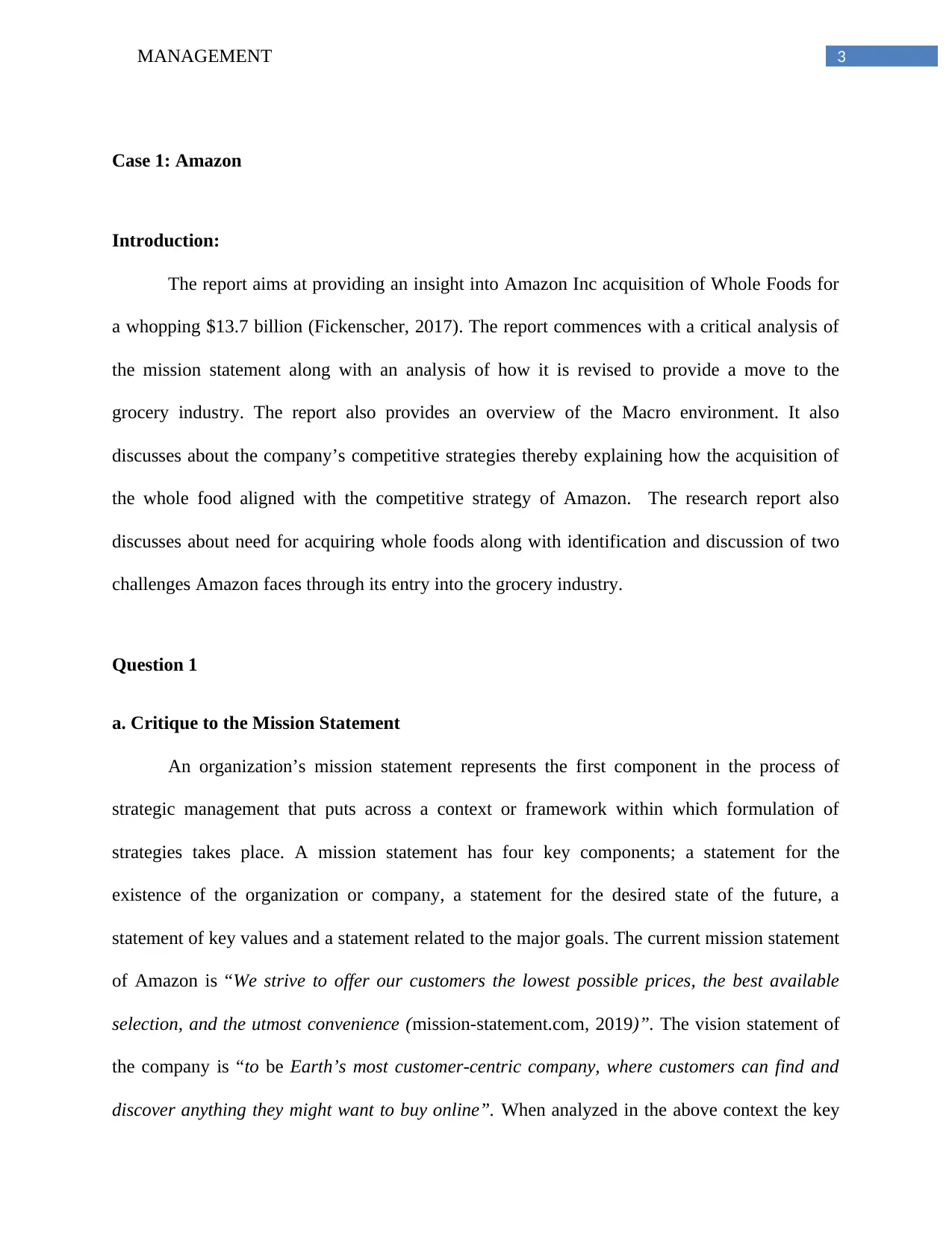
3MANAGEMENT
Case 1: Amazon
Introduction:
The report aims at providing an insight into Amazon Inc acquisition of Whole Foods for
a whopping $13.7 billion (Fickenscher, 2017). The report commences with a critical analysis of
the mission statement along with an analysis of how it is revised to provide a move to the
grocery industry. The report also provides an overview of the Macro environment. It also
discusses about the company’s competitive strategies thereby explaining how the acquisition of
the whole food aligned with the competitive strategy of Amazon. The research report also
discusses about need for acquiring whole foods along with identification and discussion of two
challenges Amazon faces through its entry into the grocery industry.
Question 1
a. Critique to the Mission Statement
An organization’s mission statement represents the first component in the process of
strategic management that puts across a context or framework within which formulation of
strategies takes place. A mission statement has four key components; a statement for the
existence of the organization or company, a statement for the desired state of the future, a
statement of key values and a statement related to the major goals. The current mission statement
of Amazon is “We strive to offer our customers the lowest possible prices, the best available
selection, and the utmost convenience (mission-statement.com, 2019)”. The vision statement of
the company is “to be Earth’s most customer-centric company, where customers can find and
discover anything they might want to buy online”. When analyzed in the above context the key
Case 1: Amazon
Introduction:
The report aims at providing an insight into Amazon Inc acquisition of Whole Foods for
a whopping $13.7 billion (Fickenscher, 2017). The report commences with a critical analysis of
the mission statement along with an analysis of how it is revised to provide a move to the
grocery industry. The report also provides an overview of the Macro environment. It also
discusses about the company’s competitive strategies thereby explaining how the acquisition of
the whole food aligned with the competitive strategy of Amazon. The research report also
discusses about need for acquiring whole foods along with identification and discussion of two
challenges Amazon faces through its entry into the grocery industry.
Question 1
a. Critique to the Mission Statement
An organization’s mission statement represents the first component in the process of
strategic management that puts across a context or framework within which formulation of
strategies takes place. A mission statement has four key components; a statement for the
existence of the organization or company, a statement for the desired state of the future, a
statement of key values and a statement related to the major goals. The current mission statement
of Amazon is “We strive to offer our customers the lowest possible prices, the best available
selection, and the utmost convenience (mission-statement.com, 2019)”. The vision statement of
the company is “to be Earth’s most customer-centric company, where customers can find and
discover anything they might want to buy online”. When analyzed in the above context the key
Paraphrase This Document
Need a fresh take? Get an instant paraphrase of this document with our AI Paraphraser
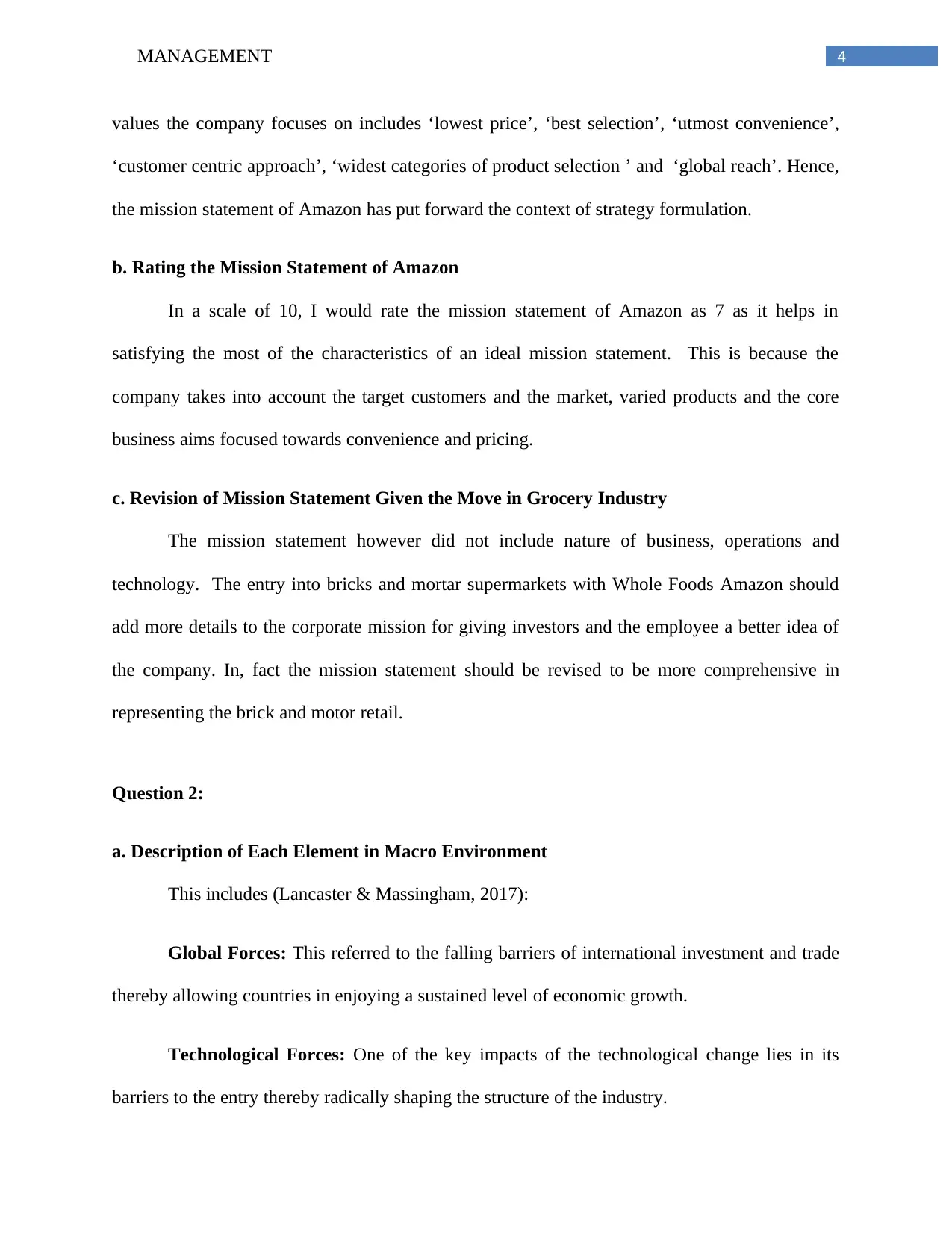
4MANAGEMENT
values the company focuses on includes ‘lowest price’, ‘best selection’, ‘utmost convenience’,
‘customer centric approach’, ‘widest categories of product selection ’ and ‘global reach’. Hence,
the mission statement of Amazon has put forward the context of strategy formulation.
b. Rating the Mission Statement of Amazon
In a scale of 10, I would rate the mission statement of Amazon as 7 as it helps in
satisfying the most of the characteristics of an ideal mission statement. This is because the
company takes into account the target customers and the market, varied products and the core
business aims focused towards convenience and pricing.
c. Revision of Mission Statement Given the Move in Grocery Industry
The mission statement however did not include nature of business, operations and
technology. The entry into bricks and mortar supermarkets with Whole Foods Amazon should
add more details to the corporate mission for giving investors and the employee a better idea of
the company. In, fact the mission statement should be revised to be more comprehensive in
representing the brick and motor retail.
Question 2:
a. Description of Each Element in Macro Environment
This includes (Lancaster & Massingham, 2017):
Global Forces: This referred to the falling barriers of international investment and trade
thereby allowing countries in enjoying a sustained level of economic growth.
Technological Forces: One of the key impacts of the technological change lies in its
barriers to the entry thereby radically shaping the structure of the industry.
values the company focuses on includes ‘lowest price’, ‘best selection’, ‘utmost convenience’,
‘customer centric approach’, ‘widest categories of product selection ’ and ‘global reach’. Hence,
the mission statement of Amazon has put forward the context of strategy formulation.
b. Rating the Mission Statement of Amazon
In a scale of 10, I would rate the mission statement of Amazon as 7 as it helps in
satisfying the most of the characteristics of an ideal mission statement. This is because the
company takes into account the target customers and the market, varied products and the core
business aims focused towards convenience and pricing.
c. Revision of Mission Statement Given the Move in Grocery Industry
The mission statement however did not include nature of business, operations and
technology. The entry into bricks and mortar supermarkets with Whole Foods Amazon should
add more details to the corporate mission for giving investors and the employee a better idea of
the company. In, fact the mission statement should be revised to be more comprehensive in
representing the brick and motor retail.
Question 2:
a. Description of Each Element in Macro Environment
This includes (Lancaster & Massingham, 2017):
Global Forces: This referred to the falling barriers of international investment and trade
thereby allowing countries in enjoying a sustained level of economic growth.
Technological Forces: One of the key impacts of the technological change lies in its
barriers to the entry thereby radically shaping the structure of the industry.
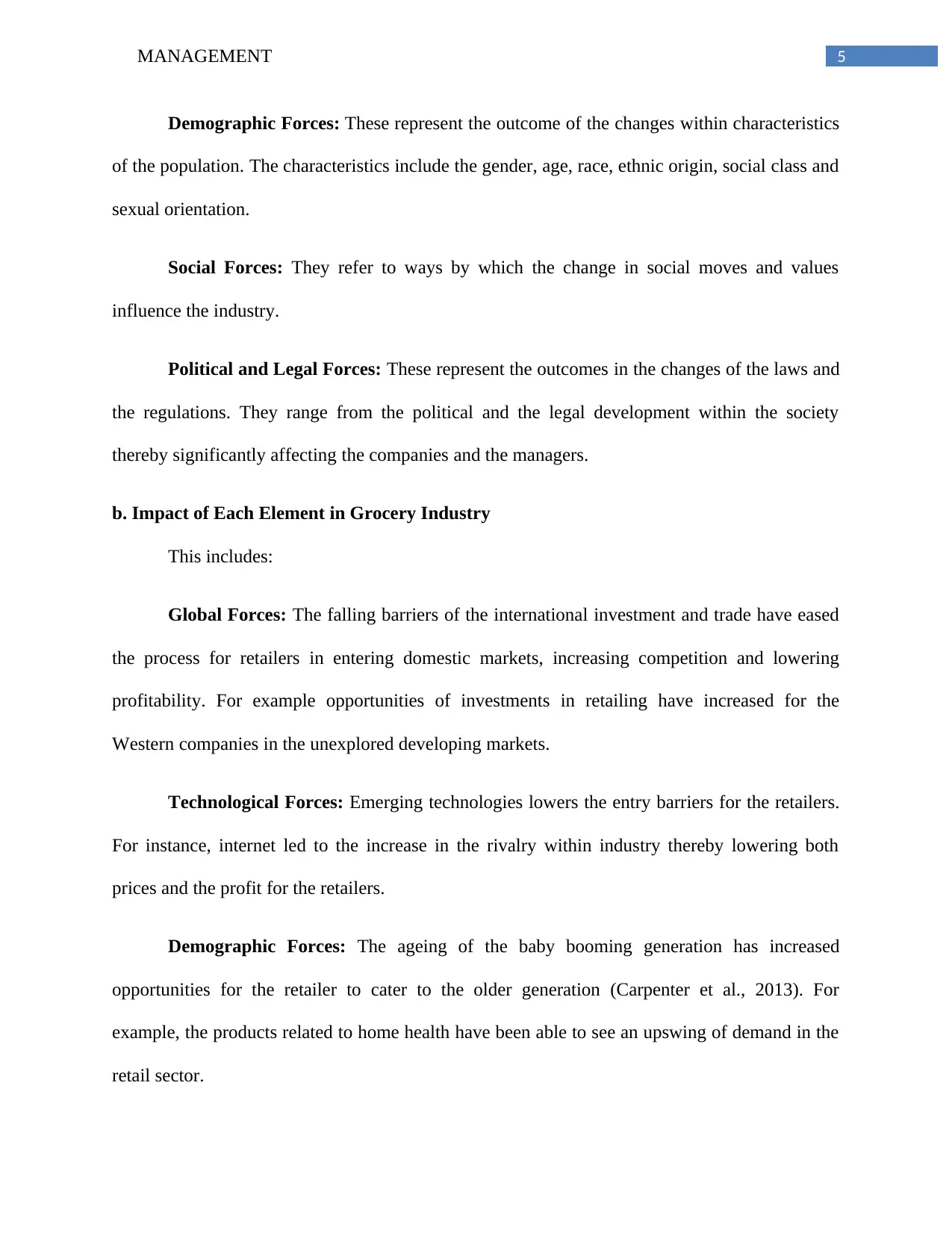
5MANAGEMENT
Demographic Forces: These represent the outcome of the changes within characteristics
of the population. The characteristics include the gender, age, race, ethnic origin, social class and
sexual orientation.
Social Forces: They refer to ways by which the change in social moves and values
influence the industry.
Political and Legal Forces: These represent the outcomes in the changes of the laws and
the regulations. They range from the political and the legal development within the society
thereby significantly affecting the companies and the managers.
b. Impact of Each Element in Grocery Industry
This includes:
Global Forces: The falling barriers of the international investment and trade have eased
the process for retailers in entering domestic markets, increasing competition and lowering
profitability. For example opportunities of investments in retailing have increased for the
Western companies in the unexplored developing markets.
Technological Forces: Emerging technologies lowers the entry barriers for the retailers.
For instance, internet led to the increase in the rivalry within industry thereby lowering both
prices and the profit for the retailers.
Demographic Forces: The ageing of the baby booming generation has increased
opportunities for the retailer to cater to the older generation (Carpenter et al., 2013). For
example, the products related to home health have been able to see an upswing of demand in the
retail sector.
Demographic Forces: These represent the outcome of the changes within characteristics
of the population. The characteristics include the gender, age, race, ethnic origin, social class and
sexual orientation.
Social Forces: They refer to ways by which the change in social moves and values
influence the industry.
Political and Legal Forces: These represent the outcomes in the changes of the laws and
the regulations. They range from the political and the legal development within the society
thereby significantly affecting the companies and the managers.
b. Impact of Each Element in Grocery Industry
This includes:
Global Forces: The falling barriers of the international investment and trade have eased
the process for retailers in entering domestic markets, increasing competition and lowering
profitability. For example opportunities of investments in retailing have increased for the
Western companies in the unexplored developing markets.
Technological Forces: Emerging technologies lowers the entry barriers for the retailers.
For instance, internet led to the increase in the rivalry within industry thereby lowering both
prices and the profit for the retailers.
Demographic Forces: The ageing of the baby booming generation has increased
opportunities for the retailer to cater to the older generation (Carpenter et al., 2013). For
example, the products related to home health have been able to see an upswing of demand in the
retail sector.
⊘ This is a preview!⊘
Do you want full access?
Subscribe today to unlock all pages.

Trusted by 1+ million students worldwide
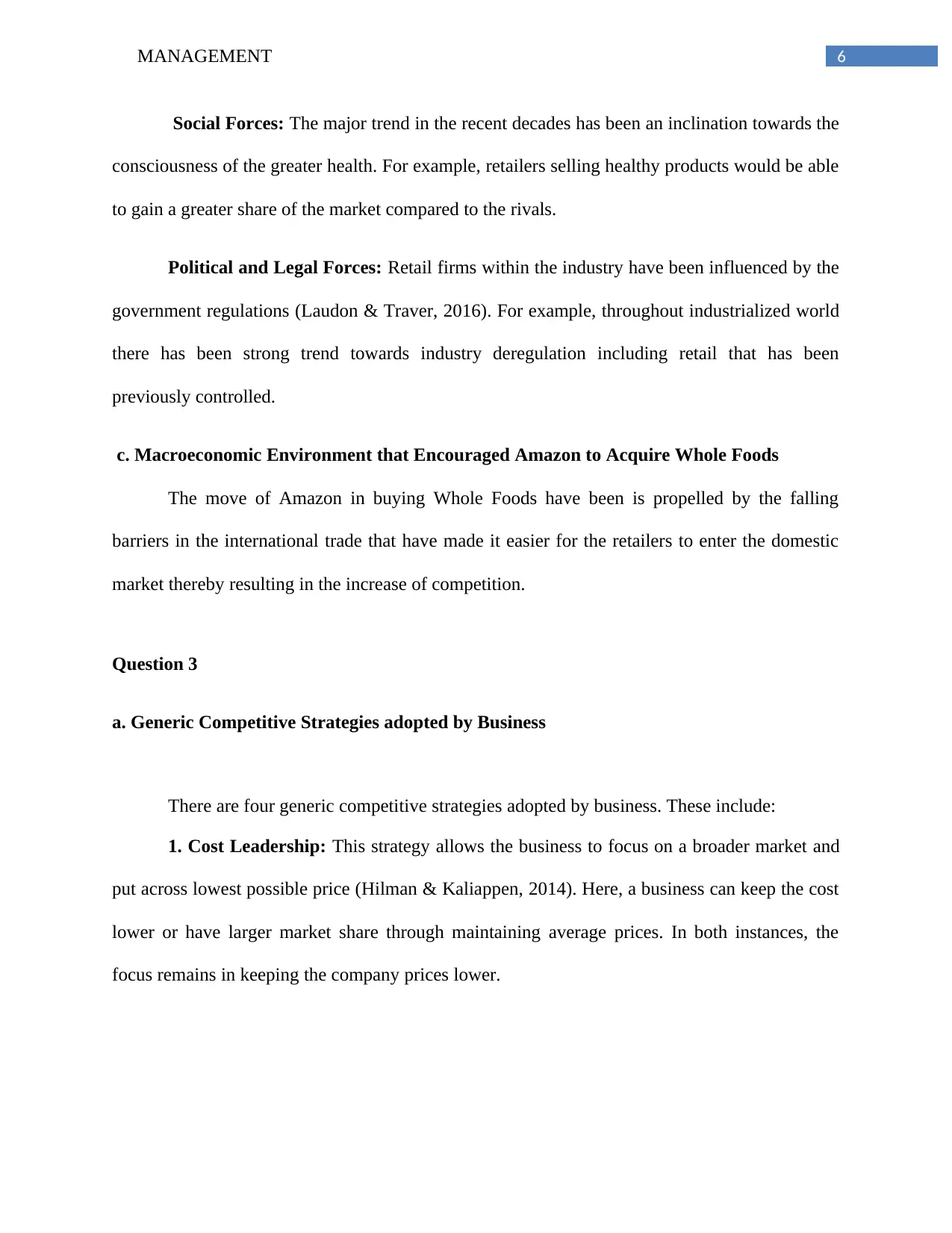
6MANAGEMENT
Social Forces: The major trend in the recent decades has been an inclination towards the
consciousness of the greater health. For example, retailers selling healthy products would be able
to gain a greater share of the market compared to the rivals.
Political and Legal Forces: Retail firms within the industry have been influenced by the
government regulations (Laudon & Traver, 2016). For example, throughout industrialized world
there has been strong trend towards industry deregulation including retail that has been
previously controlled.
c. Macroeconomic Environment that Encouraged Amazon to Acquire Whole Foods
The move of Amazon in buying Whole Foods have been is propelled by the falling
barriers in the international trade that have made it easier for the retailers to enter the domestic
market thereby resulting in the increase of competition.
Question 3
a. Generic Competitive Strategies adopted by Business
There are four generic competitive strategies adopted by business. These include:
1. Cost Leadership: This strategy allows the business to focus on a broader market and
put across lowest possible price (Hilman & Kaliappen, 2014). Here, a business can keep the cost
lower or have larger market share through maintaining average prices. In both instances, the
focus remains in keeping the company prices lower.
Social Forces: The major trend in the recent decades has been an inclination towards the
consciousness of the greater health. For example, retailers selling healthy products would be able
to gain a greater share of the market compared to the rivals.
Political and Legal Forces: Retail firms within the industry have been influenced by the
government regulations (Laudon & Traver, 2016). For example, throughout industrialized world
there has been strong trend towards industry deregulation including retail that has been
previously controlled.
c. Macroeconomic Environment that Encouraged Amazon to Acquire Whole Foods
The move of Amazon in buying Whole Foods have been is propelled by the falling
barriers in the international trade that have made it easier for the retailers to enter the domestic
market thereby resulting in the increase of competition.
Question 3
a. Generic Competitive Strategies adopted by Business
There are four generic competitive strategies adopted by business. These include:
1. Cost Leadership: This strategy allows the business to focus on a broader market and
put across lowest possible price (Hilman & Kaliappen, 2014). Here, a business can keep the cost
lower or have larger market share through maintaining average prices. In both instances, the
focus remains in keeping the company prices lower.
Paraphrase This Document
Need a fresh take? Get an instant paraphrase of this document with our AI Paraphraser
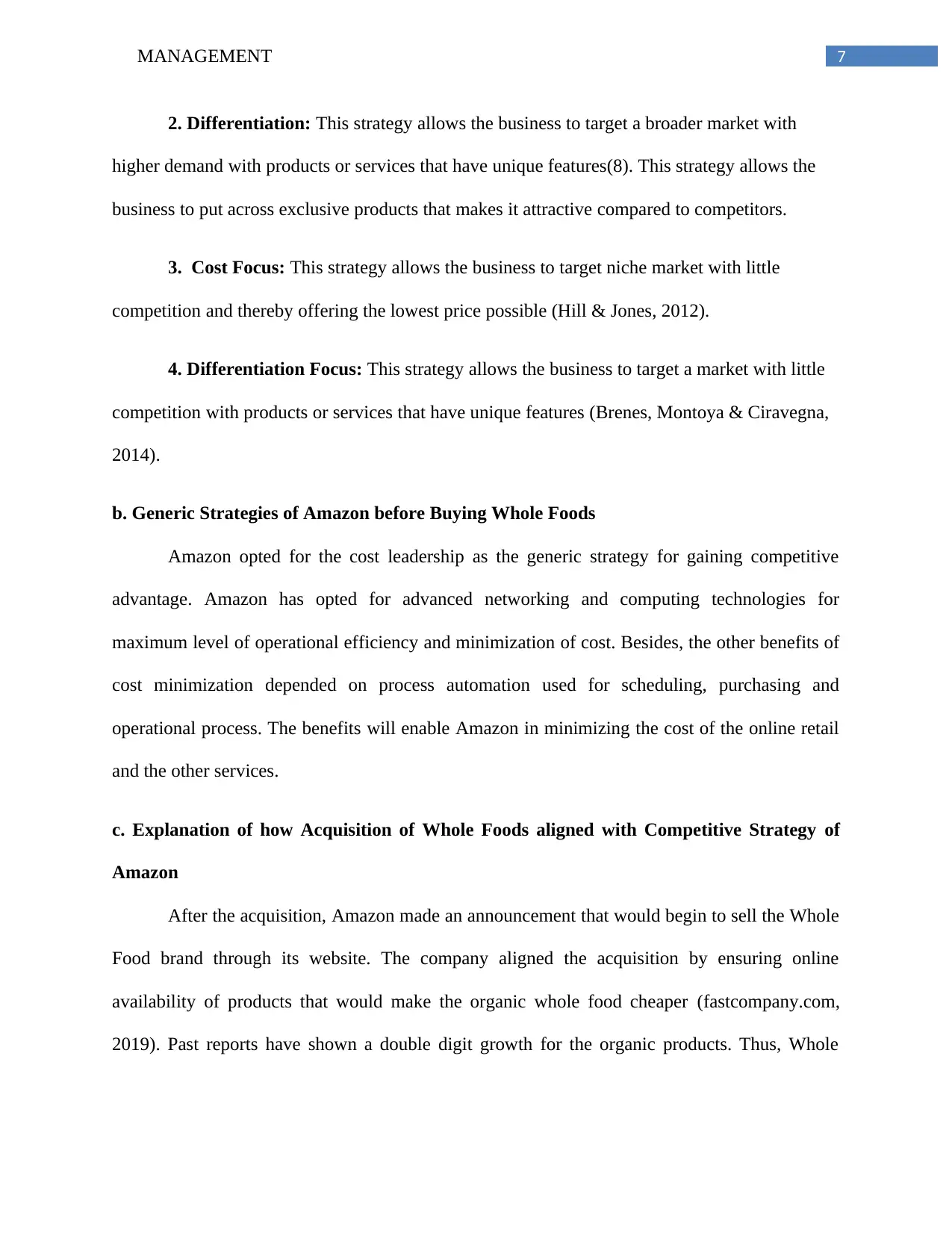
7MANAGEMENT
2. Differentiation: This strategy allows the business to target a broader market with
higher demand with products or services that have unique features(8). This strategy allows the
business to put across exclusive products that makes it attractive compared to competitors.
3. Cost Focus: This strategy allows the business to target niche market with little
competition and thereby offering the lowest price possible (Hill & Jones, 2012).
4. Differentiation Focus: This strategy allows the business to target a market with little
competition with products or services that have unique features (Brenes, Montoya & Ciravegna,
2014).
b. Generic Strategies of Amazon before Buying Whole Foods
Amazon opted for the cost leadership as the generic strategy for gaining competitive
advantage. Amazon has opted for advanced networking and computing technologies for
maximum level of operational efficiency and minimization of cost. Besides, the other benefits of
cost minimization depended on process automation used for scheduling, purchasing and
operational process. The benefits will enable Amazon in minimizing the cost of the online retail
and the other services.
c. Explanation of how Acquisition of Whole Foods aligned with Competitive Strategy of
Amazon
After the acquisition, Amazon made an announcement that would begin to sell the Whole
Food brand through its website. The company aligned the acquisition by ensuring online
availability of products that would make the organic whole food cheaper (fastcompany.com,
2019). Past reports have shown a double digit growth for the organic products. Thus, Whole
2. Differentiation: This strategy allows the business to target a broader market with
higher demand with products or services that have unique features(8). This strategy allows the
business to put across exclusive products that makes it attractive compared to competitors.
3. Cost Focus: This strategy allows the business to target niche market with little
competition and thereby offering the lowest price possible (Hill & Jones, 2012).
4. Differentiation Focus: This strategy allows the business to target a market with little
competition with products or services that have unique features (Brenes, Montoya & Ciravegna,
2014).
b. Generic Strategies of Amazon before Buying Whole Foods
Amazon opted for the cost leadership as the generic strategy for gaining competitive
advantage. Amazon has opted for advanced networking and computing technologies for
maximum level of operational efficiency and minimization of cost. Besides, the other benefits of
cost minimization depended on process automation used for scheduling, purchasing and
operational process. The benefits will enable Amazon in minimizing the cost of the online retail
and the other services.
c. Explanation of how Acquisition of Whole Foods aligned with Competitive Strategy of
Amazon
After the acquisition, Amazon made an announcement that would begin to sell the Whole
Food brand through its website. The company aligned the acquisition by ensuring online
availability of products that would make the organic whole food cheaper (fastcompany.com,
2019). Past reports have shown a double digit growth for the organic products. Thus, Whole
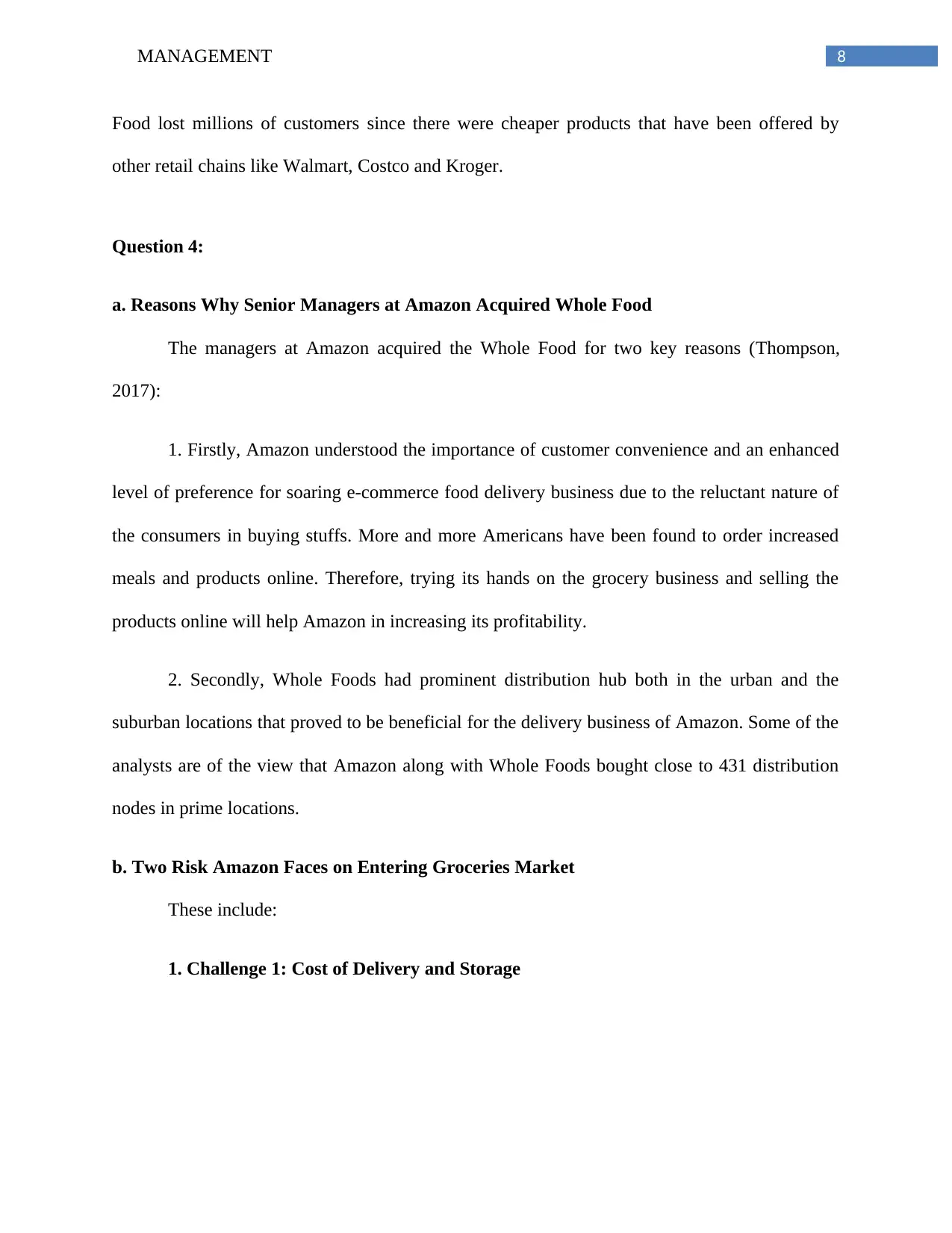
8MANAGEMENT
Food lost millions of customers since there were cheaper products that have been offered by
other retail chains like Walmart, Costco and Kroger.
Question 4:
a. Reasons Why Senior Managers at Amazon Acquired Whole Food
The managers at Amazon acquired the Whole Food for two key reasons (Thompson,
2017):
1. Firstly, Amazon understood the importance of customer convenience and an enhanced
level of preference for soaring e-commerce food delivery business due to the reluctant nature of
the consumers in buying stuffs. More and more Americans have been found to order increased
meals and products online. Therefore, trying its hands on the grocery business and selling the
products online will help Amazon in increasing its profitability.
2. Secondly, Whole Foods had prominent distribution hub both in the urban and the
suburban locations that proved to be beneficial for the delivery business of Amazon. Some of the
analysts are of the view that Amazon along with Whole Foods bought close to 431 distribution
nodes in prime locations.
b. Two Risk Amazon Faces on Entering Groceries Market
These include:
1. Challenge 1: Cost of Delivery and Storage
Food lost millions of customers since there were cheaper products that have been offered by
other retail chains like Walmart, Costco and Kroger.
Question 4:
a. Reasons Why Senior Managers at Amazon Acquired Whole Food
The managers at Amazon acquired the Whole Food for two key reasons (Thompson,
2017):
1. Firstly, Amazon understood the importance of customer convenience and an enhanced
level of preference for soaring e-commerce food delivery business due to the reluctant nature of
the consumers in buying stuffs. More and more Americans have been found to order increased
meals and products online. Therefore, trying its hands on the grocery business and selling the
products online will help Amazon in increasing its profitability.
2. Secondly, Whole Foods had prominent distribution hub both in the urban and the
suburban locations that proved to be beneficial for the delivery business of Amazon. Some of the
analysts are of the view that Amazon along with Whole Foods bought close to 431 distribution
nodes in prime locations.
b. Two Risk Amazon Faces on Entering Groceries Market
These include:
1. Challenge 1: Cost of Delivery and Storage
⊘ This is a preview!⊘
Do you want full access?
Subscribe today to unlock all pages.

Trusted by 1+ million students worldwide
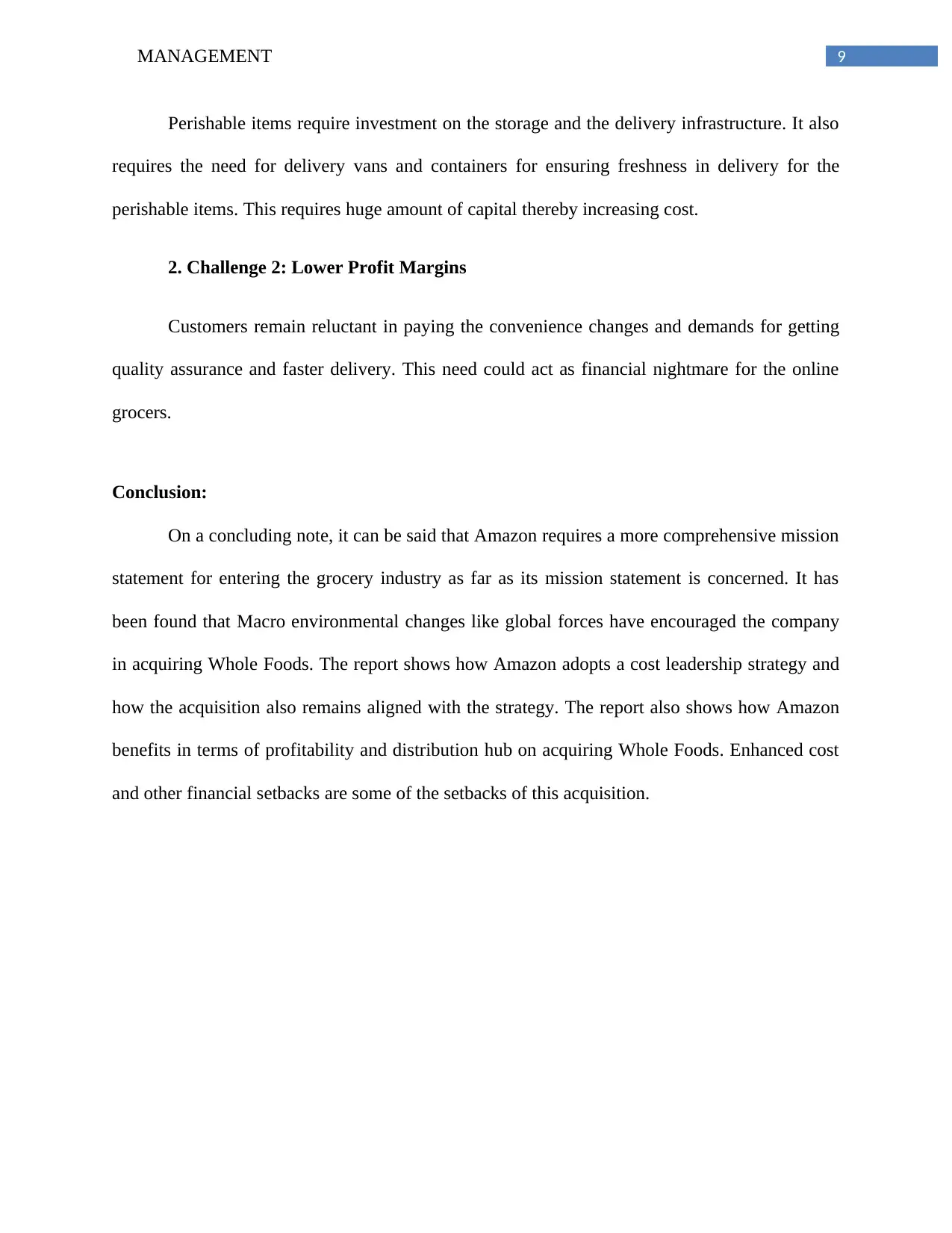
9MANAGEMENT
Perishable items require investment on the storage and the delivery infrastructure. It also
requires the need for delivery vans and containers for ensuring freshness in delivery for the
perishable items. This requires huge amount of capital thereby increasing cost.
2. Challenge 2: Lower Profit Margins
Customers remain reluctant in paying the convenience changes and demands for getting
quality assurance and faster delivery. This need could act as financial nightmare for the online
grocers.
Conclusion:
On a concluding note, it can be said that Amazon requires a more comprehensive mission
statement for entering the grocery industry as far as its mission statement is concerned. It has
been found that Macro environmental changes like global forces have encouraged the company
in acquiring Whole Foods. The report shows how Amazon adopts a cost leadership strategy and
how the acquisition also remains aligned with the strategy. The report also shows how Amazon
benefits in terms of profitability and distribution hub on acquiring Whole Foods. Enhanced cost
and other financial setbacks are some of the setbacks of this acquisition.
Perishable items require investment on the storage and the delivery infrastructure. It also
requires the need for delivery vans and containers for ensuring freshness in delivery for the
perishable items. This requires huge amount of capital thereby increasing cost.
2. Challenge 2: Lower Profit Margins
Customers remain reluctant in paying the convenience changes and demands for getting
quality assurance and faster delivery. This need could act as financial nightmare for the online
grocers.
Conclusion:
On a concluding note, it can be said that Amazon requires a more comprehensive mission
statement for entering the grocery industry as far as its mission statement is concerned. It has
been found that Macro environmental changes like global forces have encouraged the company
in acquiring Whole Foods. The report shows how Amazon adopts a cost leadership strategy and
how the acquisition also remains aligned with the strategy. The report also shows how Amazon
benefits in terms of profitability and distribution hub on acquiring Whole Foods. Enhanced cost
and other financial setbacks are some of the setbacks of this acquisition.
Paraphrase This Document
Need a fresh take? Get an instant paraphrase of this document with our AI Paraphraser
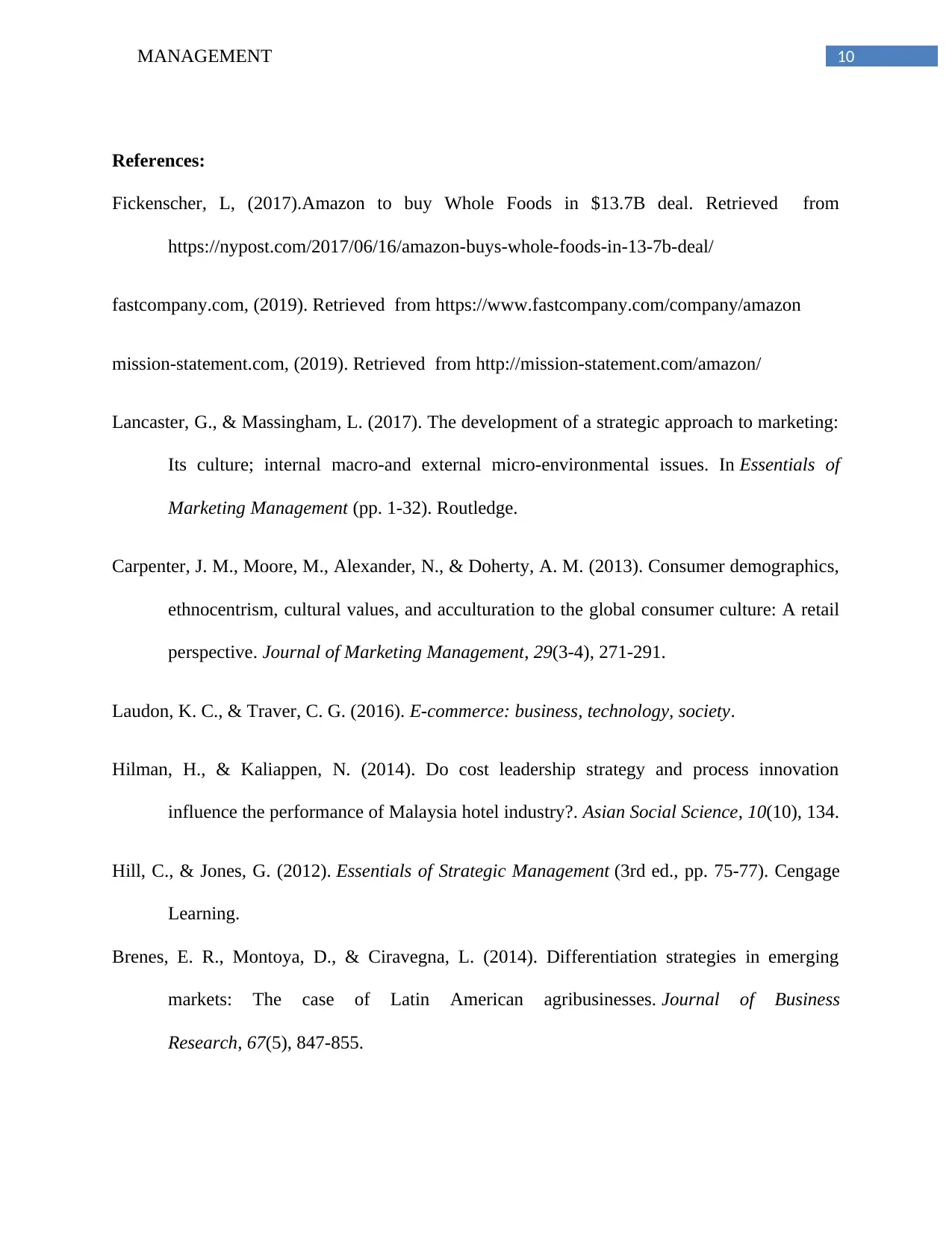
10MANAGEMENT
References:
Fickenscher, L, (2017).Amazon to buy Whole Foods in $13.7B deal. Retrieved from
https://nypost.com/2017/06/16/amazon-buys-whole-foods-in-13-7b-deal/
fastcompany.com, (2019). Retrieved from https://www.fastcompany.com/company/amazon
mission-statement.com, (2019). Retrieved from http://mission-statement.com/amazon/
Lancaster, G., & Massingham, L. (2017). The development of a strategic approach to marketing:
Its culture; internal macro-and external micro-environmental issues. In Essentials of
Marketing Management (pp. 1-32). Routledge.
Carpenter, J. M., Moore, M., Alexander, N., & Doherty, A. M. (2013). Consumer demographics,
ethnocentrism, cultural values, and acculturation to the global consumer culture: A retail
perspective. Journal of Marketing Management, 29(3-4), 271-291.
Laudon, K. C., & Traver, C. G. (2016). E-commerce: business, technology, society.
Hilman, H., & Kaliappen, N. (2014). Do cost leadership strategy and process innovation
influence the performance of Malaysia hotel industry?. Asian Social Science, 10(10), 134.
Hill, C., & Jones, G. (2012). Essentials of Strategic Management (3rd ed., pp. 75-77). Cengage
Learning.
Brenes, E. R., Montoya, D., & Ciravegna, L. (2014). Differentiation strategies in emerging
markets: The case of Latin American agribusinesses. Journal of Business
Research, 67(5), 847-855.
References:
Fickenscher, L, (2017).Amazon to buy Whole Foods in $13.7B deal. Retrieved from
https://nypost.com/2017/06/16/amazon-buys-whole-foods-in-13-7b-deal/
fastcompany.com, (2019). Retrieved from https://www.fastcompany.com/company/amazon
mission-statement.com, (2019). Retrieved from http://mission-statement.com/amazon/
Lancaster, G., & Massingham, L. (2017). The development of a strategic approach to marketing:
Its culture; internal macro-and external micro-environmental issues. In Essentials of
Marketing Management (pp. 1-32). Routledge.
Carpenter, J. M., Moore, M., Alexander, N., & Doherty, A. M. (2013). Consumer demographics,
ethnocentrism, cultural values, and acculturation to the global consumer culture: A retail
perspective. Journal of Marketing Management, 29(3-4), 271-291.
Laudon, K. C., & Traver, C. G. (2016). E-commerce: business, technology, society.
Hilman, H., & Kaliappen, N. (2014). Do cost leadership strategy and process innovation
influence the performance of Malaysia hotel industry?. Asian Social Science, 10(10), 134.
Hill, C., & Jones, G. (2012). Essentials of Strategic Management (3rd ed., pp. 75-77). Cengage
Learning.
Brenes, E. R., Montoya, D., & Ciravegna, L. (2014). Differentiation strategies in emerging
markets: The case of Latin American agribusinesses. Journal of Business
Research, 67(5), 847-855.
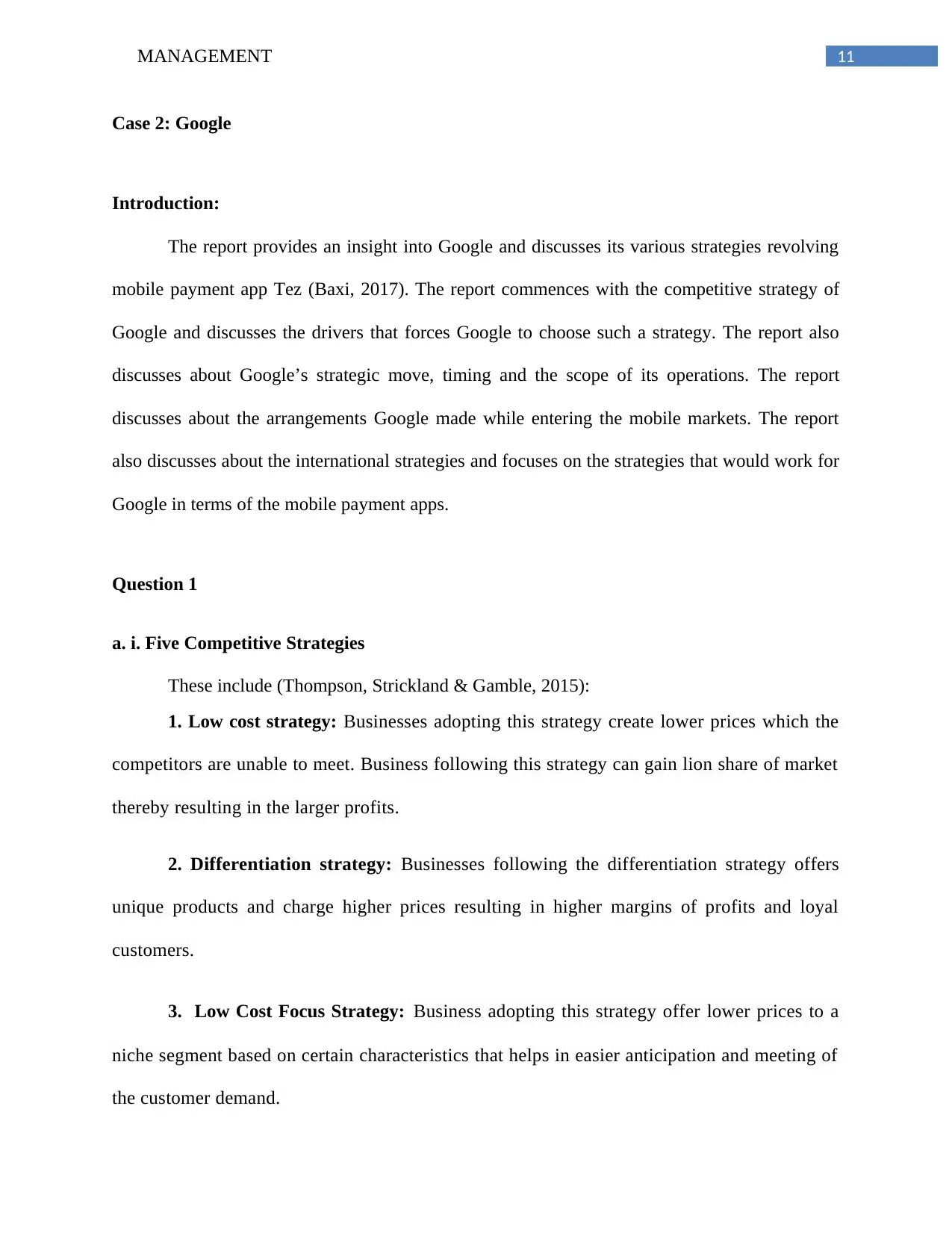
11MANAGEMENT
Case 2: Google
Introduction:
The report provides an insight into Google and discusses its various strategies revolving
mobile payment app Tez (Baxi, 2017). The report commences with the competitive strategy of
Google and discusses the drivers that forces Google to choose such a strategy. The report also
discusses about Google’s strategic move, timing and the scope of its operations. The report
discusses about the arrangements Google made while entering the mobile markets. The report
also discusses about the international strategies and focuses on the strategies that would work for
Google in terms of the mobile payment apps.
Question 1
a. i. Five Competitive Strategies
These include (Thompson, Strickland & Gamble, 2015):
1. Low cost strategy: Businesses adopting this strategy create lower prices which the
competitors are unable to meet. Business following this strategy can gain lion share of market
thereby resulting in the larger profits.
2. Differentiation strategy: Businesses following the differentiation strategy offers
unique products and charge higher prices resulting in higher margins of profits and loyal
customers.
3. Low Cost Focus Strategy: Business adopting this strategy offer lower prices to a
niche segment based on certain characteristics that helps in easier anticipation and meeting of
the customer demand.
Case 2: Google
Introduction:
The report provides an insight into Google and discusses its various strategies revolving
mobile payment app Tez (Baxi, 2017). The report commences with the competitive strategy of
Google and discusses the drivers that forces Google to choose such a strategy. The report also
discusses about Google’s strategic move, timing and the scope of its operations. The report
discusses about the arrangements Google made while entering the mobile markets. The report
also discusses about the international strategies and focuses on the strategies that would work for
Google in terms of the mobile payment apps.
Question 1
a. i. Five Competitive Strategies
These include (Thompson, Strickland & Gamble, 2015):
1. Low cost strategy: Businesses adopting this strategy create lower prices which the
competitors are unable to meet. Business following this strategy can gain lion share of market
thereby resulting in the larger profits.
2. Differentiation strategy: Businesses following the differentiation strategy offers
unique products and charge higher prices resulting in higher margins of profits and loyal
customers.
3. Low Cost Focus Strategy: Business adopting this strategy offer lower prices to a
niche segment based on certain characteristics that helps in easier anticipation and meeting of
the customer demand.
⊘ This is a preview!⊘
Do you want full access?
Subscribe today to unlock all pages.

Trusted by 1+ million students worldwide
1 out of 19
Your All-in-One AI-Powered Toolkit for Academic Success.
+13062052269
info@desklib.com
Available 24*7 on WhatsApp / Email
![[object Object]](/_next/static/media/star-bottom.7253800d.svg)
Unlock your academic potential
Copyright © 2020–2025 A2Z Services. All Rights Reserved. Developed and managed by ZUCOL.